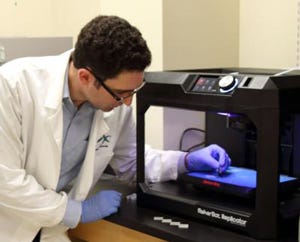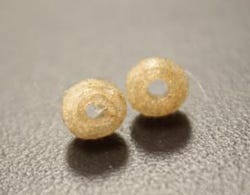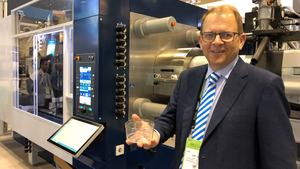New 3D-printing technology fabricates resorbable beads for smart implants
In another medtech first for 3D printing, researchers at Louisiana Tech University (Ruston, LA) have developed a method for using consumer-grade 3D printers and materials to fabricate custom medical implants embedded with antibacterial and chemotherapeutic compounds. Doctoral students and research faculty from Louisiana Tech's biomedical engineering and nanosystems engineering programs collaborated to create filament extruders that can make medical-quality 3D-printing filaments.
September 15, 2014
In another medtech first for 3D printing, researchers at Louisiana Tech University (Ruston, LA) have developed a method for using consumer-grade 3D printers and materials to fabricate custom medical implants embedded with antibacterial and chemotherapeutic compounds. Doctoral students and research faculty from Louisiana Tech's biomedical engineering and nanosystems engineering programs collaborated to create filament extruders that can make medical-quality 3D-printing filaments. Creating these filaments, which have specialized properties for drug delivery, is a new concept that can result in smart drug-delivering medical implants or catheters, according to the team of researchers.
|
Doctoral student Jeffery Weisman. |
"Through the addition of nanoparticles and/or other additives, this technology becomes much more viable using a common 3D-printing material that is already biocompatible," said Jeffery Weisman, a doctoral student in Louisiana Tech's biomedical engineering program. "The material can be loaded with antibiotics or other medicinal compounds, and the implant can be naturally broken down by the body over time."
Dr. David K. Mills, professor of biological sciences and biomedical engineering, and some of his students had been working on 3D-printing applications when the idea of printing antibiotic beads using PMMA or some other bioresorbable material came up. He sought the advice of Weisman and Connor Nicholson, a doctoral candidate in nanosystems engineering. Ultimately, the team developed what it says is an innovative approach that overcomes many of the limitations of current drug-delivery systems. Extrusionbot LLC (Phoenix, AZ), the maker of the Extrusionbot filament extruder and 3D-printing materials supplier, provided important materials support throughout the development and testing process.
|
Bioresorbable 3D-printed beads. |
Antibiotic implants, or beads, typically are made from bone cement that is hand-mixed by a surgeon during a surgical procedure and contain toxic carcinogenic substances, according to a news release on the university website. These beads, which are actually a type of Plexiglas, do not break down in the body, and a second surgical procedure is required to remove them. Weisman and his team's custom 3D-print filaments can be made of bioplastics, which can be resorbed by the body, thus avoiding the need for additional surgery.
The 3D-printing process developed at Louisiana Tech allows for the creation of partially hollow beads that provide for a greater surface area and increased drug delivery and control.
"Currently, embedding additives in plastic requires industrial-scale facilities to ensure proper dispersion throughout the extruded plastic," says Mills. "Our method enables dispersion on a tabletop scale, allowing researchers to easily customize additives to the desired levels."
"It is truly novel and a worldwide first to be 3D printing custom devices with antibiotics and chemotherapeutics," says Mills.
About the Author(s)
You May Also Like






